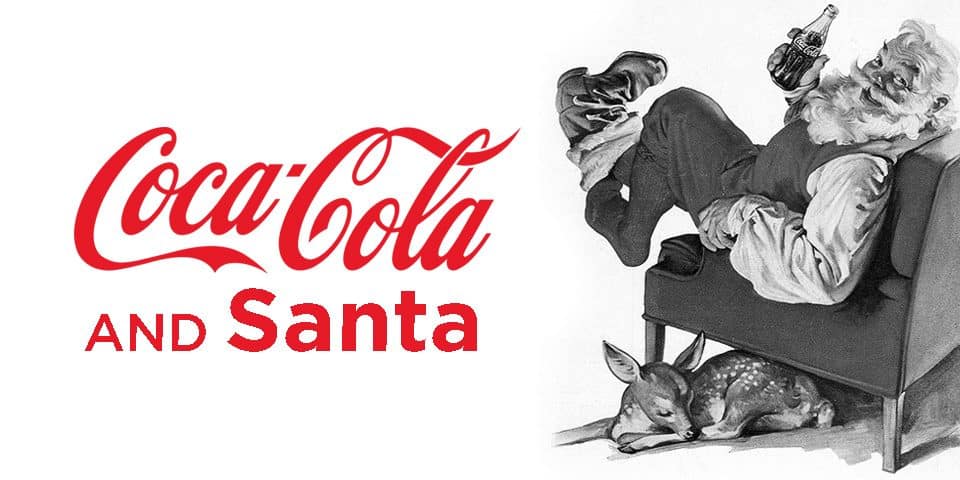
Email Strategies You Should Be Automating
November 23, 2016
Brand New Year, Brand New You
February 14, 2017Santa Claus is the result of a Coke deal.

The guy with the red suit and cap, the thick black belt and sooty boots, the rosy cheeks – is the spawn of an advertising campaign by Coca-Cola back in the 1930s.
Surprised? Don’t be. As far as Coca-Cola is concerned, this is public knowledge. The company is open about its role in popularizing Santa; it has even sponsored gallery exhibitions on “Advertising as Art” that explain how it all happened, one of which was held at the Carrousel du Louvre, in Paris, in 1996. Here’s the story:
Back in the late 19th century, when Coca-Cola was new, the whole purpose of the beverage was medicinal. If you were feeling “low” or if you suffered from headaches, a Coke was the perfect remedy. The featured ingredient – cocaine, or coca-bean extract – guaranteed a renewed agility and acuity. Indeed, many people found out about Coke from their pharmacists; the company paid pharmacists a commission if drugstores allowed them to install a carbonation tap on the premises.
By the 1930s, Coca-Cola needed to re-evaluate its business plan. The more controversial aspects of the beverage had long been dealt with (as early as 1903, the coca bean extract was removed and caffeine took its place), but it was the Depression; beverage sales were slow – especially in the wintry months – and Coca-Cola needed a new hook and line to attract the American market.
So, in 1931, Coca-Cola changed its target audience: from the adult looking for a pharmaceutical pick-me-up to the whole family. Coca-Cola was now a great taste to be enjoyed by everyone! To bring the point home, the company launched an extensive advertising campaign that pioneered the use of well-known artists as ad designers. Coca-Cola blitzed pharmacies and stores with promotional material suitable for the whole family.
The most successful illustrations were by a Swedish artist named Haddon Sundblom, whose work depicted a portly white man in a red suit bringing joy to family and friends with a bottle of Coke. The figure in the illustrations was the first modern Santa.
Naturally, Coke can’t take full credit for bringing Santa into the homes and hearts of Americans everywhere; the full history of Santa Claus is much longer than the history of the Coca-Cola company.
In the United States, the Dutch were primarily responsible for spreading the idea of Sante Klaas, whose character was based on one of their revered bishops. Sante Klaas gave form to the current myth of Santa and fleshed out his reputation as a gift-giver: eight flying reindeer, living near the North Pole, filling socks with presents, arriving through the chimney.
As a jolly man in a red suit, Santa Claus is pure Coke. The company found that Haddon Sundblom’s image of Santa Claus – modeled, incidentally, on a retired salesman named Lou Prentice – hit the right buttons in terms of stirring the hearts and quenching the thirsts of consumers everywhere. The company contracted with Sundblom to continue making Coke ads with this model for the next 35 years.
Using Sundblom’s version of Santa, Coca-Cola orchestrated a full frontal attack on the market. Santa-Coke propaganda was everywhere. Magazine advertisements were particularly popular, as were point-of-purchase promotional items. Collectibles, too, were another way that Coca-Cola expanded its presence – a strategy that is standard today for any advertiser, from Camel to Nike.
Coca-Cola also patented a formula for the bright red color used for Coke packaging and for Santa’s suit. Any artist working for Coca-Cola was required to use this color red; every Santa in every Coke ad was the exact same red color as the Coke label. As with its famous bottle, Coke had given birth to a nearly universal American icon.
Cheers to the New Year! Wishing you a Happy Holiday season from the team at Creative At Work Advertising Inc.
This article was published in The Boston Phoenix a few years back and it’s too good not to share.

